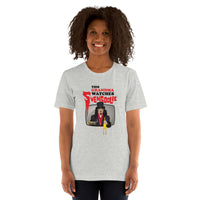How Raymond Burr ended up battling Godzilla
Before he became Perry Mason, Burr was taking on giant lizards.

On March 1, 1954, a Japanese fishing boat named Daigo Fukuryū Maru was seeking tuna in the middle of the Pacific Ocean. Meanwhile, a bit farther west at the Bikini Atoll, the United States detonated a 15 megaton hydrogen bomb as part of its Castle Bravo test. The fallout from the blast drifted eastward, blowing past the Daigo Fukuryū Maru and contaminating and burning the skin of its crew. Months later, one of them would die.
The incident did little to smooth over tensions between the United States and Japan, just nine years after the bombings of Hiroshima and Nagasaki. The tragedy also gave an idea to film producer Tomoyuki Tanaka. Equally inspired by an American sci-fi flick from the prior year, 1953's The Beast from 20,000 Fathoms, Tanaka wrote up an outline for a new movie about an irradiated monster attacking Tokyo. Thus, Godzilla was born.
Toho Studios released Godzilla in November of 1954. The film tapped into the nuclear anxiety of the nation. There was some romance, too — or at least an arranged marriage between the heroine and a scientist. The film had a pointed anti-nuclear message, and warned at its close that continued testing could lead to more Godzillas.
Nearly 10 million tickets were sold in Japan, about one for every nine citizens in the country. The movie grossed more than $2 million in its homeland, about as much as the Frank Sinatra and Doris Day vehicle Young at Heart was pulling in the States. Naturally, it was bound to capture Hollywood's attention.
The original Godzilla first made it over to the U.S. months later, screening in cities with large Japanese populations. Edmund Goldman caught one of these screenings in Los Angeles and quickly snatched up the film rights for $25,000. He then flipped the rights to Jewell Enterprises Inc., a smaller production company. There was just one problem. The films message and anti-American resentment, not to mention that arranged marriage, were not going to play well with American audiences. About a third of the original film was cut out of the movie. It had to be filled with something.
To patch the holes and sell the thriller to Americans, Jewell decided to shoot new footage and seamlessly splice it in to the original. Raymond Burr, who had recently completed Rear Window, not to mention B-movies like Gorilla at Large and Tarzan and the She-Devil, was cast as reporter Steve Martin, a journalist on the scene to witness the kaiju's destruction. The production did a clever job of inserting Burr into the picture. Burr was shot acting with extras who had their backs to the camera, so that he could then be spliced into scenes, appearing to chat with the original actors. Another character, a young translator by Martin's side, was added for comic relief.
Burr's work was completed in a single day, filming in a tiny L.A. studio for nearly 24 straight hours. A new title was slapped on the movie — Godzilla, King of the Monsters! This time, after the beast is defeated, Burr optimistically noted, "The monster was gone. The whole world could wake up and live again." It was a stark contrast to the somber warning of the Japanese original.
The movie made decent money here in April of 1956. That same month, Burr would audition for Perry Mason.






2 Comments


























